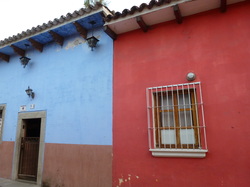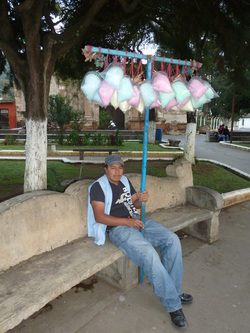
As a resident of both Hawaii and of the Pacific Northwest, I’m no stranger to vistas which include awe inspiring mountains and even active volcanos. But Guatemala. the land of “eternal spring,”is unique. Cradled in the Panchoy Valley,12,325 foot inactive Agua Volcan rises to a dramatic peak. While Agua Volcan appears to be the highest mountain in the vicinity, in fact Acatenago to the west, at 13,900 feet, is even higher. Next to Acatenango are the active Fuego Volcanos. Like Hawaii’s Kilauea, Volcan Pacaya emits slow flowing lava and it is possible to get quite near the lava with a reasonable uphill trek. I have met travelers who have even roasted marshmallows over the hot spot at the top of Pacaya!
I settled for a shorter excursion on my first day though, content with climbing to the roof of my hotel to more fully enjoy the 360 degre view and also to look down on the tile roofs and the inner courtyards of the city. The grand arch of Santa Catalina and the ornate church of La Merced dominate the skyline of the city. The bells of Antiqua's churches punctuate the mornings and evenings. From the roof it is also possible to see evidence of the city's colonial architecture as well as the remaining ruins from the 1773 earthquakes.
Across the cobblestone street from my hotel room I hear the soft and regular sound of hands patting. Two women wearing Mayan skirts (cortes) and blouses (huipils) slap the maza, the cornmeal dough, into flat round tortillas which they place on the brazier to cook. These tortillas are made fresh every day by women in the doorways of tiendas and then sold, warm, to the surrounding families to stuff like tacos with frijoles and rice or to fold and dip into savory bowls of soup.



Cotton candy vendors roam the parks carrying trees of pink and blue spun sugar enclosed in clear bags. Young lovers kiss without pause or self-consciousness as workers with machetes weed the flowers and ornamental plants. Groups of men meet and talk over newspapers. Women sell roasted corn, chile relleno sandwiches, peeled pineapple and papaya topped with a spoonful of chile while children play with brightly colored balls. Foreign students emerge from the nearby language schools to smoke cigarettes on the benches and clear their minds of wriggling conjugations of verbos while Guatemaltecos pass on the street, the white sticks of lollipops protruding from their mouths.
Sometimes I am serenaded by a group of primary school children wearing pleated skirts, dark pants and white shirts under school uniform sweaters. A few of the children carry drums while others tote metal instruments shaped like lyres, but with metal bars like xylophones, played by striking the metal keys with mallets. Their teacher leads them in “Are you sleeping, brother Juan?” and “Twinkle, twinkle, little star.” The lyres make a sweet chiming sound, like hundreds of little bells.
Antigua is a city with mixed population of Mayan indigenous peoples, Ladinos and also foreigners who come to learn Spanish or to explore Guatemala, a county which remains "off the beaten track" of international tourism despite it's rich cultural heritage. The people here are welcoming and curious about where I have come from and why I am in Guatemala. Every day I exchange greetings with nearly everyone I pass on the street, "Hola, Buenos Dias," we each say with a smile.
Antigua is a wonderful base for my exploration of Guatemala, not only because the city herself holds endless treasures but also because Antigua is well located for exploring the surrounding pueblos including the home of the giant kites of Sumpango~!
And yes, for learning more Spanish, tambien.


 RSS Feed
RSS Feed

